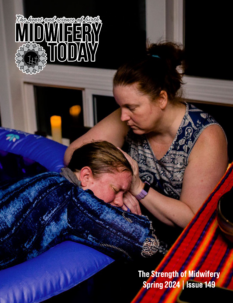
Monet Moutrie—monetnicole.com
What If, What For and What Now: Human Rights and Cultural Rights in Childbirth
Editor’s note: This article first appeared in Midwifery Today, Issue 119, Autumn 2016.
Subscribe to Midwifery Today Magazine
One of the most tragic destructions of indigenous sacred female knowledge is the false superiority and medicalization of childbirth by professionals among native peoples.
The aboriginal of Australia; the Inuit of Northern Canada; the multifarious tribes of the United States; the indigenous peoples of Mexico, Central and South America; and the Genus peoples of Africa have but few remains of their great wisdom and ways to preserve life at birth. The infiltration and globalization of the Western model for resuscitation is the most harmful of all. Traditional midwives who had a wide variety of methods for assisting first breaths, primarily leaving the cord intact and then leaving length when severing the cord, have been made to feel dangerous, stupid and useless to the very people they love and seek to help.
The various trainings of professionals to bring medical resuscitation programs to indigenous and deeply skilled and widely experienced traditional midwives do not recognize the harm they leave behind. When confident women follow orders and learn and repeat the ways of foreigners due to social, economic, cultural or personal pressures, the loss is immeasurable. Personal confidence is destroyed. Knowledge is destroyed. Culture is destroyed. Lives can be destroyed. More than once has a midwife after such “skilled training courses” felt paralyzed in the face of a depressed baby, looking frightened and bewildered, unable to do what she knew from her traditions and unable to do the new, foreign and unfamiliar techniques. The clean mannequin and the ready testing site look nothing like the wet baby on a common hut floor.
I witnessed firsthand as ministers of health called together indigenous midwives throughout Mexico. The ministers would test the midwives and train them to leave behind their “harmful, useless or unsubstantiated skills, knowledge and attitudes.” They were shamed and threatened into replacing “backward” practices with actions that were proven to be “safe and scientific.” Without access to any of the equipment or transport vehicles that the authorities were insisting they use, these human treasures had one foot in two worlds with nowhere to stand. Their old ways were forbidden and the new ways unreachable as well as distrusted.
And for good reason! The use of 100% positive pressure ventilation as the standard I was taught in 1993 and forward until 2016 has harmed our babies. For this reason, I created Newborn First Breaths, where I can teach observable behaviors in the mother that contribute directly to supporting the physiological first breaths of her newborn.
When a biological function such as birth is forbidden or restricted, as we see in hospital or practice protocols; when threats, coercion, lies, bullying and disparity become common place, as we see in such statements as, “So, you just want to hold a dead baby”; when abnormal becomes the norm, as we see in rates of inductions and cesareans, then reclamation becomes political. If the preservation of normal birth is to survive beyond the underground, then rights must be upheld legally. Human rights are not always legal rights, but legal rights are meant to uphold human rights. Human rights in childbirth are meant for all peoples—indigenous peoples too, whose ways may be unfamiliar or unobservable by dominant cultures.
Women need power to birth. The spirit and the will need energy. When the village midwives talk to me about turning their mothers over to the “the system,” they worry about the lack of prayers in the hospitals. Their worries reflect the loss of traditions and sacred rituals that save the spirit of the people as well as their bodies. Traditional rituals can be so elaborate that it takes a lifetime to learn them and pass them on. Yet, in one generation of forbidden participation, much, if not all, is lost. Human rights include the basic right to wear a necklace with a saint or a medicine bag while being asked to remove clothing and wear a “costume gown.” It includes the right to keep someone with you that you know—someone of your own choosing and perhaps several someones. It includes the right to use your voice to say yes or no. To ask more questions and to change locations, care providers or even to simply leave and go home.
One woman I spoke with in England told me the story of needing to go into a hospital with her third baby, a stillborn, after birthing two children at home. She was afraid. She spoke with a strong voice, “If you want me to stay, you need to look at me when you speak to me, ask before you touch me and don’t hurt me. If you do, I will punch you and run, because that is what I do when I get afraid.” Hermine Hayes-Klein, lawyer and founder of Human Rights in Childbirth, has inspired me with her strong, clear and passionate legal messages that inform women of their basic human rights, even in childbirth and even at the very moment of birth. I now encourage every pregnant mother to review her website: humanrights inchildbirth.org. It gives them the confidence to set boundaries with family, friends, foes and health care providers and most importantly to stay strong and confident within themselves. This steadiness allows them to live close to their own instinctual knowing. What greater right do we have than the right to our own knowing?
I spoke recently with the chief of the Northern Cherokee Nation. Rights are simple to the Cherokee. Instinct and the right to say no are to be respected. It is so simple that 2-year-olds can do it. We have a right to be where we want to be anwd to be with whom we choose. We have the right to say no to anyone doing anything to our body that we do not want or understand. We have the right to ask questions and get help without ridicule or threat. We have the right to trust nature and to trust in our own nature, which is our instinct. Chief Grey Elk said, “The only way to take over a woman’s body when nature would have it otherwise is to take over her mind first.” How can we protect our right to freedom of thought? We must protect the inner life of women from the beginning. Birth is the beginning of everything else. There is the universal maternal behavior to look at, speak to, reach out and touch and draw her baby to her breast. Every mother has the right to do so undisturbed. How have we let something so elemental to our being be placed in the hands of a stranger not of our choosing? How can we begin to take back a right that we have given up out of ignorance and fear?
Our obsession with safety in childbirth has endangered the maternal instinct that would protect both mother and baby. Fear is our core instinct; and when fear is manipulated during childbirth, nearly all mothers will agree to procedures from which they would otherwise run. The right to birth with a birth team whose goals and tools are to inspire, uplift, encourage and empower a birthing woman is her basic human right. How she does so is her cultural right.
Native peoples have more than healing traditions, rituals and direct lineage access to ancient wisdom and practices. They have a cultural way of assessing new influences to determine if they are healthy and worth incorporating. The elders in my tribe often ask this question: “Will it sustain the tribe for thousands of years?” Something new can enhance, encourage or evolve the tribe or it can undermine, devalue or destroy what nature and instinct would preserve. Instinct injury is the greatest loss to survival and happiness. In Jean Liedloff’s book, The Continuum Concept, she gifts the world a beautiful story of an indigenous chief creating what we would call a play pen for his child. He chooses select trees for the wood. He works on it for many days. He makes it just right and lovely. Proud and finished, he picks the child up and places him in the middle. The child screams. The chief removes him immediately and takes a hatchet and destroys the invention.
We can be that wise. We can see that the machine or medicine is causing harm and destroy it before it destroys us.
We have grown a world where mutual recognition of respect and autonomy is not enough. Human rights must become legal rights in our complex global social structures. Education about human rights becomes equally important. At one gathering of midwives in Mexico in the 1990s, we taught each other about human rights using a recently published pamphlet from the World Health Organization. Over and over the village women asked, “Are these rights for women, too? Not just men?” Women need more human rights than men. We give birth. We sustain the future of the tribe through growing, birthing and nourishing the next generation with our very bodies. We need clear, respectful, irrevocable and inarguable basic humanitarian legal rights to self-determine where, with whom and how we birth.
We also have the right to change our minds.
I am very aware of the need for a paradigm shift toward community involvement with birthing mothers. People are afraid of birth. Even emergency room doctors and paramedics are afraid of birth. “They would rather handle a gunshot wound.” This is a direct quote from one of my colleagues in the field. Because disaster relief programs across the nations include nothing other than transport to the nearest emergency site, Ruth Walsh developed Basic Disaster Birth Support (BDBS). BDBS with the EmerGently guide developed by the Global Midwifery Council works to put normal birth back into the consciousness of the global citizen. Grandmothers have become silent. Friends and family feel ignorant and helpless. We have lost the joy and wonder and celebration of birth that lets a mother move through pregnancy and labor surrounded by calm loved ones and familiar environments. Indigenous people’s rituals and prayers often don’t work when exposed to unbelievers. Such undermining uses the natural mystery of life and birth to breed fear rather than curiosity and trust. What to do?
Learning more has not helped. Science proves and disproves on a daily basis and keeps everyone reading and confused. Meanwhile, mothers are birthing their babies. Maybe the Cherokee can help. Maybe simple and sacred can help. Maybe returning birth to community by way of village prenatals can help. Together we can circle the earth and start a new wave of hope and joy.
Inspired by human, legal and cultural rights, let’s get started.

 Sister MorningStar has dedicated a lifetime to the preservation of instinctual birth. She birthed her own daughters at home and has helped thousands of other women find empowerment through instinctual birth. She is the founder of a spiritual retreat center and author of books related to instinctual and spiritual living. She lives as a Cherokee hermitess and Catholic mystic in the Ozark Mountains of Missouri. Visit her on the web at:
Sister MorningStar has dedicated a lifetime to the preservation of instinctual birth. She birthed her own daughters at home and has helped thousands of other women find empowerment through instinctual birth. She is the founder of a spiritual retreat center and author of books related to instinctual and spiritual living. She lives as a Cherokee hermitess and Catholic mystic in the Ozark Mountains of Missouri. Visit her on the web at: 
















